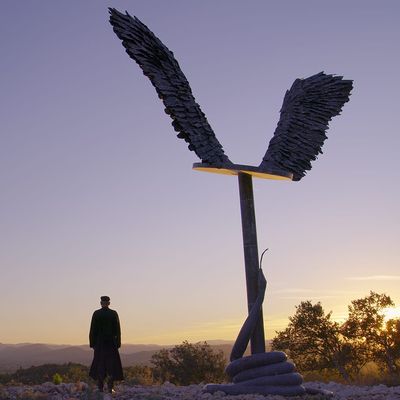
Anselm, Wim WendersÔÇÖs new documentary about the artist Anselm Kiefer, is currently playing theatrically in 3-D, and you should try to catch it in that format if you have the chance. This isnÔÇÖt the gee-whiz 3-D of objects flying off the screen, however, or even the 3-D of immersive environments. Much as he did with his 2011 documentary, Pina, Wenders uses three dimensions in almost sculptural fashion, allowing us to take in the weight and texture of a work, or a movement. ItÔÇÖs an apt format for someone like Kiefer, whose immense paintings (if they could even be called that) incorporate stone and sand and straw and other objects, not to mention great thick mounds of paint. His sculptures and installations also demonstrate a captivating coarseness that really demand oneÔÇÖs physical presence.
The film opens with haunting images of headless womenÔÇÖs busts covered in white bridal dresses, works created as part of KieferÔÇÖs massive installation ÔÇ£La Ribaute,ÔÇØ which the artist spent decades building on an old, 40-hectare silk factory in southern France. ÔÇ£La RibauteÔÇØ incorporated many of his artistic ideas and formats within something that also worked as a grand expression of time. While we do not get much detail about ÔÇ£La RibauteÔÇØ from the film, we do experience something else. In 3-D, the dresses seem to hover halfway between our eyes and the screen, solid ghosts emerging from film to commune with the world of the real. Then Wenders cuts to another corner of ÔÇ£La Ribaute,ÔÇØ to one of the ÔÇ£Seven Heavenly Palaces,ÔÇØ rickety towers made of rusty, discarded shipping containers, glowing so strange and alien in this sunny, pastoral corner of France. Again, itÔÇÖs hard not to feel as if we can touch these fragile things, to see if theyÔÇÖll turn to dust or collapse in our hands.
Kiefer and Wenders were born a few months apart in 1945, in the midst of GermanyÔÇÖs death spiral at the end of World War II. They came of age during the so-called ÔÇ£years of silence,ÔÇØ when Nazism and the Holocaust were rarely discussed. Wenders responded by seeking escape, making road movies about dreamers, drifters, and depressives. Kiefer responded by digging in, making art that refused to leave, either spiritually or physically. (Even if he did eventually move, his work has remained very much German ÔÇö much to many of his countrymenÔÇÖs displeasure.) A series of photographs of the artist giving the Nazi salute in different countries while wearing his fatherÔÇÖs Wehrmacht uniform provoked understandable outrage, but the idea was to remind Germany and the world of how ordinary citizens behaved and felt during the war, to cut through the lie that these were strange things that happened to other people in far off, imaginary lands. (One shudders to imagine how such images would be received today.)
So, while Kiefer has had a fascinating and controversial life and career, he is also one of those artists whose work prompts filmmakers to steer clear of straightforward documentary style. (In case youre wondering how this man is able to afford these massive studios, these huge stretches of land, these impossible, decades-long projects  well, hes also one of the richest people in France, where he now lives.) The director Sophie Fienness excellent 2010 film, Over Your Cities Grass Will Grow, was similarly ethereal in its approach, opting to let the camera wander through the dank, ominous spaces of La Ribaute, as Kiefer went about his work.
Wenders does include snippets of other news documentaries on the artist, shown on what appears to be an antique TV screen in KieferÔÇÖs studio. But even these are provided loosely, often sans context and in no discernible order. They feel like another stray element tossed into the mix, not a through-line. If art is meant to enthrall, disturb, and evoke, mere information sometimes threatens to get in the way. Wenders seems to understand that. On the soundtrack, we hear spoken Paul CelanÔÇÖs legendary ÔÇ£Death Fugue,ÔÇØ a poem about the Holocaust that has also served as a key text for Kiefer; the words seem to drift by in expressive waves, elemental and organic rather than composed and figurative.
When we do see Kiefer at work in Anselm, he seems less like an artist and more like a mad contractor, smudging paint in seemingly indiscriminate globs with thick, unwieldy sticks, or using long poles and forklifts to pour molten metal onto his canvases. It all seems like a rather solitary endeavor, and one wonders if this is part of the expressive mythology Wenders is buying into. Surely, this extremely wealthy 78-year-old artist who makes enormous, complicated, industrial works in giant studios also has a small army of assistants helping him. But we do not see much of the actual labor that goes into creating these canvases and sculptures. This adds to the sense that they were born, not created.
Or maybe excavated from the inner reaches of the earth, molded out of the blood and mud and cruelty of history. This is unclean, messy work, and the film seems determined to highlight that. As Kiefer pulls off a shelf and flips through one of the immense books heÔÇÖs created (out of lead and dirt and black paint and, of course, semen) or throws sculpted dresses off a winding staircase and onto a dusty floor, you can feel the soot and the paint and the grime flecking and floating off. The way he films Kiefer, Wenders finds more drama in gestures such as these than he might in biographical detail. This is art that dares to live in the world, and Anselm is itself a wonderfully alive work.
More Movie Reviews
- Alien: Romulus Gets the Job Done, But at What Cost?
- Blitz Is the Worst Movie Steve McQueen Has Made
- When an American Pursues Bulgarian Dreams


